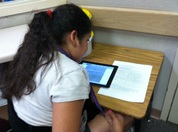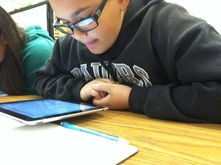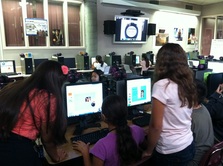|
Common Core State Standards are coming to California and will be fully implemented during the 2014-15 school year. As a Common Core trainer for Palm Springs Unified, I am very excited about the transition to CCSS and have already begun to pilot the standards in part this year. One thing that I have come to realize is that Common Core may not represent the same giant instructional shift for some that it will for others. In case you are unfamiliar with the major instructional shifts that CCSS will require in literacy instruction (in all content areas), here is a Haiku Deck that I created. If you view the entire deck on the Haiku Deck website, you will find that each slide is annotated with additional information. As you read through the instructional shifts, you may find that there are some practices you are already enacting in your classroom. I believe Common Core will most strongly affect teachers who are entrenched in teacher-centered content delivery and those who do not fully extend the instructional process to include student creation of original content. Another area in which I think some teachers may potentially experience growing pains is the effective implementation of student-centered technology. Though the impact of each one of these instructional shifts directly relates to who you are as a teacher and the type of classroom you foster, there are several practices all teachers can implement (or verify that they are implementing) now - regardless of where your school site or district is in the transition process.  1. Begin introducing more informational text, preferably from primary sources. For example, I taught a literary selection called "The Bracelet" this year, which is about a young Japanese-American girl who experienced Japanese internment during WWII. After we finished our literary analysis, I introduced several primary source documents related to Japanese internment, including the full text of Executive Order 9066, a set of internment instructions given to Japanese-Americans living on Bain Bridge Island, WA during WWII, and the Proclamation 4417 addressed to Japanese-Americans and written by President Gerald Ford in 1976. The combination of these rigorous texts of varying complexity, as well as video interviews I found online featuring actor George Takei, actor Pat Morita, and other internment survivors, helped students build a thorough understanding of this time in history. The result was a much deeper quality of learning than students would have achieved if I had limited instruction to the literary text alone.  2. Increase text complexity and provide scaffolding via model texts. During the same instructional unit above, I utilized the first paragraph of each primary source as a model text. We waded through the complex sentences as a whole class, highlighting, annotating, and crossing out redundancy as we worked. I offered careful support to students throughout the process, asking "I don't know, what do you think?" more than giving outright answers. Students then repeated the process with their small group for subsequent paragraphs of each primary source. Perhaps the biggest challenge for me during this sequence was allowing students to struggle. Sometimes, it feels as though we aren't doing our job as teachers unless we step in to assist. Often, this help comes too quickly and our response should be less immediate. Shifting the locus of control to the student is key to ensure students construct meaning from the text, not teacher-centered delivery.  3. Build digital literacy with students and give opportunities for content creation. Whether as a result of the numerous standards we currently teach or district mandated pacing guides, a common teacher complaint is, "We don't have enough time to include technology." Many of us frequently contend that technology integration should be part of students' regular learning environment. The goal of giving students the chance to create products using technology isn't based on the desire to use technology; it is based on the notion that students should develop digital literacy skills that are transferrable to college and career. Ensuring students are well prepared for their future job market means providing consistent opportunities for them to author original content digitally. Become good at troubleshooting a lack of devices if your school site is does not have sufficient resources. Leverage student devices if possible, and group students together to share as needed. The transition to Common Core will not be without its challenges, and the standards may not be perfect, but I truly do feel confident that CCSS will benefit many students in California. Hopefully, it will transform the rote instruction that undoubtedly exists at many schools into a more dynamic process.
If you have questions about Common Core State Standards or opinions you'd like to share, feel free to comment on this post. Don't forget to log on to Twitter for #CAedchat this Sunday night at 8pm Pacific, because we'll be discussing Common Core and what it means for the future of education. See you there!
0 Comments
Your comment will be posted after it is approved.
Leave a Reply. |
Author: Jessica PackCalifornia Teacher of the Year. CUE Outstanding Educator 2015. DIGICOM Learning Teacher Consultant. 6th Grade Teacher. Passionate about gamification, Minecraft, digital story-telling, and fostering student voices. Download:Archives
June 2020
Categories
All
|

 RSS Feed
RSS Feed